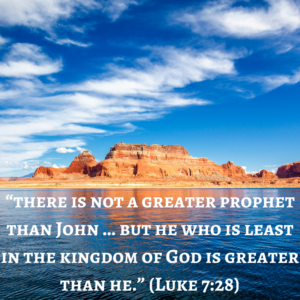
I’m attempting to show how a simple model of biblical prophecy arises out of Jesus’ Olivet Discourse. So far, I’ve taken the following steps: (1) Showed how our understanding of prophecy affects how we understand the Lord’s Great Commission and His Model Prayer; (2) explained why we should begin discovering the prophetic model in the Olivet Discourse; (3) discussed Jesus’ subject in the Olivet Discourse—the temple’s fall; (4) mentioned that the disciples asked two questions in response, one about when these things would happen, and the other about signs that would indicate their nearness; and (5) showed that the when question is the same in Matthew, Mark, and Luke. (See earlier posts.1)
Let’s continue.
Two accounts of the sign question show this same similarity. Here is how Mark and Luke have it:
What will be the sign when all these things will be fulfilled? (Mark 13:4)
What sign will there be when these things are about to take place? (Luke 21:7)
The subject of the sign question is the same as the when question: “these things” related to the temple’s fall.
Matthew’s expanded version of the sign question lets us take a significant step forward in our quest for the biblical framework of prophecy. He says the disciples ask,
What will be the sign of Your coming, and of the end of the age? (Matt 24:3)
By comparing this form of the question to those in Mark and Luke, we learn that a question about the temple’s fall was also one about “the coming” of Christ and “the end of the age.”
I feel compelled to restate my earlier caution: We must not allow our previous ideas about these two things—the coming of Christ and the end of the age—to separate what God has joined in this passage. The three gospel writers link the temple’s destruction to the Lord’s coming and the end of the age. Matthew, Mark, and Luke are recording the same conversation, so this connection is an unavoidable conclusion.
But how can we reconcile Matthew’s account to Mark’s and Luke’s? I’ll tackle the simple part first—the relationship between the temple’s fall and the end of the age. From ancient times, the Jews thought within a two-age framework that defined all history. They spoke about “this age” and “the future age.” The coming of the Messiah would mark the transition from one to the other. For them, “this age” was the period that preceded His coming. During His ministry, He would establish “the age to come.”
Let’s assign names to these two ages. We Christians believe Jesus is the Messiah. Before He came to redeem His people, God had defined His relationship with them through the Mosaic law. So, I will call the period from Moses to Jesus the “Mosaic age.” For the disciples, “this age” was the age in which they lived—the Mosaic age.
The temple—following the tabernacle—stood as the most important symbol of Jewish identity. The Jews considered it the center of the universe, the place where heaven and earth met. Above all, it was the place where God’s presence dwelt. The temple was the center of Mosaic-age life.
So, it’s easy to see why Matthew recorded the disciples’ question as he did: The temple’s fall would end the Mosaic age. They wanted to know the sign regarding the end of that age, not about the end of history. We can reconcile Matthew’s account of the sign question to those of Mark and Luke by recognizing that the temple’s fall would mean the end of the Mosaic age.
Now, let’s name the other age in the Jewish two-age framework: The Messiah would establish it, so let’s call it the “messianic age,” the age following His coming—the age in which we now live. Because He promised to build His church in this age (Matt 16:18), we can also call it the “church age.”
The disciples’ sign question in Matthew shows that the temple’s fall would be the dividing line between these two ages; it would separate the Mosaic age from the messianic age.
Now, let’s deal with the more challenging part of the sign question in Matthew: How would the temple’s fall relate to the Lord’s coming?
The key to this riddle lies in the Greek term the disciples used for “coming.” I’ve promised to use as few Greek words as possible, but in this case, you need to know they used parousia, which means “presence.” Here is the literal rendering of the disciples’ query: “Tell us … what is the sign of thy presence?” (Matt 24:3 YLT).
Young’s Literal Translation—the version I’ve quoted—always uses “presence” to translate parousia. However, most translations use “coming” instead of “presence.” They are, in part, right—someone’s presence in a place requires their coming there. But Matthew knew the disciples had a more extensive idea in mind.
Let me explain with an illustration: Our grandson visits us for a week each summer. Betty and I look forward to his “coming.” But we enjoy more than his arrival at a certain point; we relish his “presence” with us for an extended period. Ultimately, he returns to his parents, and life returns to normal. The word parousia covers everything in this sequence of events—our preparations, Peter’s visit, and his return trip.
My proposition is that the disciples are not asking only about the Lord’s arrival; they want to know about His ongoing presence with them during the messianic age.
This meaning makes sense of the disciples’ question. Jesus said the temple would fall; the place of God’s presence during the Mosaic age would perish. (Remember, the “bread of the Presence” was there—Exodus 35:13 ESV.) The disciples knew the Lord’s presence must then dwell with His people in a new way during the messianic age.
The prophets had foretold this new way. For example, God used Zechariah to say,
“Sing and rejoice, O daughter of Zion! For behold, I am coming and I will dwell in your midst,” says the LORD. “Many nations shall be joined to the LORD in that day, and they shall become My people. And I will dwell in your midst.” (Zech 2:10–11)
The disciples knew the Messiah (Jesus) had come. They also knew Jesus had told them the Father would send the Holy Spirit after His departure. He had said, “I will not leave you orphans; I will come to you” (John 14:18).
In the Olivet Discourse, the disciples learn that the temple’s fall would end the old Mosaic-age way of God dwelling with His people. So, they ask the Lord for a sign regarding His messianic-age presence with them.
From our vantage point, we know that Jesus, after His resurrection, made an important announcement about His ongoing presence:
He said to them, “It is not for you to know times or seasons which the Father has put in His own authority. But you shall receive power when the Holy Spirit has come upon you; and you shall be witnesses to Me in Jerusalem, and in all Judea and Samaria, and to the end of the earth.” (Acts 1:7–8)
The Lord, in the Person of the Holy Spirit, would dwell with His people, giving us the power to fulfill the Great Commission. After the temple fell, “Many nations [would] be joined to the Lord” (Zech 2:11).
Conclusion
With all this in mind, here is my amplified version of the disciples’ two questions in Matthew:
When will these things [related to the temple’s fall] be? And what will be the sign of Your coming [that is, Your messianic-age presence], and of the end of the [Mosaic] age? (Matt 24:3)
Mark and Luke have the sign question relate to the “these things” of the temple’s fall; Matthew has it pertain to the results of the temple’s demise: the end of the Mosaic age and the messianic-age presence of the Lord with His people.
The following diagram shows these relationships:

Seeing the disciples’ two questions this way helps us pray Jesus’ Model Prayer: “Your kingdom come. Your will be done on earth as it is in heaven” (Matt 6:10). It also helps us obey His Great Commission to “make disciples of all the nations” (Matt 28:19). We can do both in faith because of Christ’s parousia—His presence with us in this age.
The disciples were asking about the temple’s fall, not the end of history or anything else in our future.
Footnotes
- For a full-length account of this prophetic model, see Michael A. Rogers, Inmillennialism: Redefining the Last Days (Tullahoma, TN: McGahan Publishing House, 2020). It is available here. For a summary, see the free PDF here.
